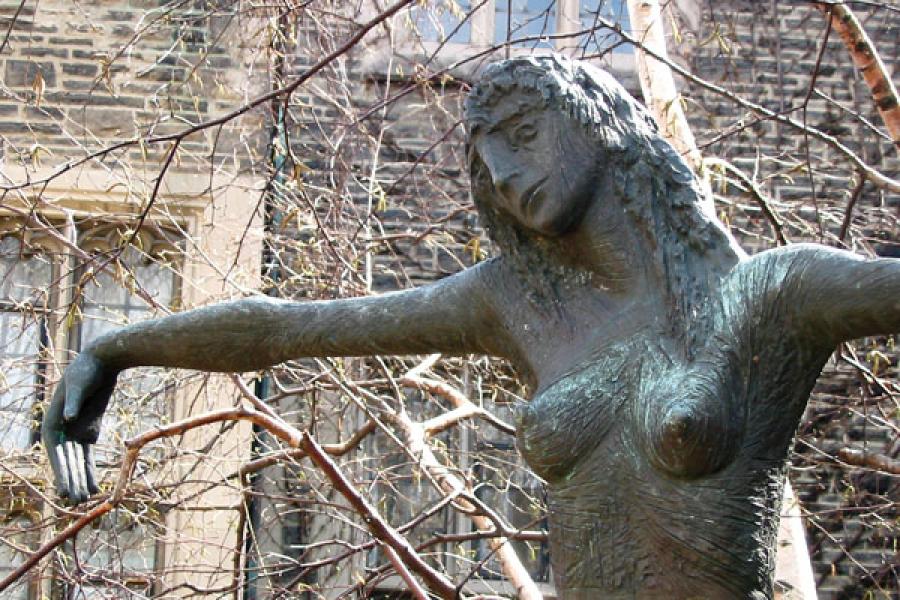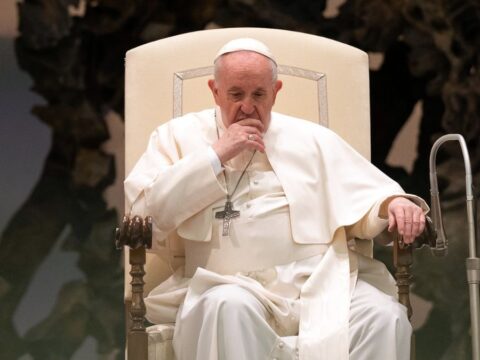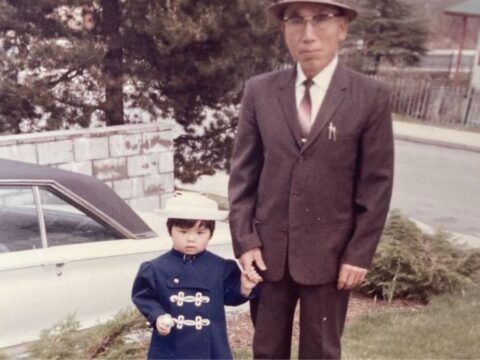An imposing print of Leonardo da Vinci’s The Last Supper has hung above my grandmother’s couch for as long as I can remember. It’s no ordinary picture. When the light hits it a certain way, the image morphs into a bust of Jesus, and no matter where you sit, Jesus’ gaze follows you.
Religious paraphernalia — plastic crosses, decorative religious plates, a smattering of porcelain churches and angels — filled my childhood home. I vowed that when I moved out, I would never own a plastic church or velvet Jesus. Ever.
You may unsubscribe from any of our newsletters at any time.
My iconoclasm was short-lived. As an adult, I embraced the materiality of religion in spite of myself. Nearly every room in our home has a religious object in it. Above the recliner where I sit to write, there’s a portrait of Jesus called Lord of the Woods by Reimer Reinke, a German-Canadian artist and the father of a former parishioner. When you look carefully, Jesus’ face appears in the trees.
While I like to think that I’ve embraced the artfulness of Christian imagery and not the sentimental kitsch, my Lord of the Woods might be as creepy to some as my grandmother’s shifty-eyed Jesus is to me. Whereas Grandma’s Jesus highlights personal piety, mine underscores divinity in ecology. But are there other reasons we’ve transported Jesus into our homes? Why for nearly 2,000 years have we devoted so much energy trying to discover and imagine what Jesus looked like? What do images of Jesus do for us, and why have certain features stuck?

Barrie Schwortz’s photographs of the Shroud of Turin, a roughly four-metre-long burial cloth said to have retained the imprints of Jesus’ features, have been exhibited the world over. Schwortz was a photographer on the team of scientists that examined the shroud in 1978. Since then, he has gathered and disseminated the science of the shroud, which, after spending 17 years as a skeptic, he now believes is authentic. It’s an unlikely obsession for a Jewish man raised in an Orthodox home. “We had two sets of silverware, Friday candles and morning prayers — like Fiddler on the Roof. So why is a good Jewish boy like me doing this? Well, it means a lot to people. When it was on exhibit in New Zealand and the Philippines, we had to get pillows out because people fell down before it, the tears streaming down their faces. The image really touches people.”
Schwortz thinks doubt drives the quest to discover the physicality of Jesus. “People’s faith can be weakened from time to time. Perhaps in the cloth, there is a little reminder for the Thomases of the world.”
I guess uncovering Jesus’ grainy image on a piece of cloth is reassuring. But that doesn’t explain why we invest time creating images, nor does it explain how they work. Maybe their power lies partly in our frame of mind.
David Morgan chairs the religion department at Duke University in North Carolina and is an expert in visual religious culture. He says that images have a unique effect on the brain. “When we see things, we code them in several different ways. We code them in terms of memory. We code them in terms of rational thinking. We code them linguistically. We code them emotionally. These structures of the brain are enmeshed. Images are powerful because they stimulate these various brain centres, integrating the systems.” Neurologically speaking, saying “A picture is worth a thousand words” is like comparing apples to oranges; images are in a category of their own.

United Church artist Willis Wheatley’s Jesus Christ, Liberator (popularly known as “Laughing Jesus”) and Stanley Spencer’s Christ in the Wilderness: The Scorpion are two of my favourite images of Jesus. In 1973, Wheatley challenged conventional characterizations of Jesus by portraying him in the throes of a belly laugh. Spencer, an English artist, dispensed with handsome renditions of Jesus in 1939, painting a squat, bushy-bearded Jesus cradling a scorpion in his pudgy hands. When I look at these images, I can practically feel my neurons firing. I don’t have the same reaction when I look at Jesus’ image in the coins that Texas-based historical archeologist Ronald Stewart recently unveiled. Still, I can’t take my eyes off them.
Stewart tells me that the 38-piece coin collection he purchased from a New York City dealer in 2004 and invested nine years in trying to authenticate were previously misidentified. Originally dated a century before Christ, the coins are actually from AD 33-47, he says, and portray scenes from Jesus’ life. If he’s right, Stewart will have the earliest-known depiction of Jesus. (The next runner-up is Christ Healing the Paralytic, a wall painting created in AD 232 at an early house church in Dura-Europos, a town in today’s Syria.)
Stewart and I chat on the phone while watching his online video. While he explains that 2,000 years ago, people observed and created images differently, I squint at his video demonstration. The Jesus figure on the coin looks like a shifting black blob. I can barely trace the outline. But still, I spend a lot of time trying, replaying the video over and over. I’m not entranced by the coins because they reinforce my faith, and I doubt they have the same neurological impact as Spencer’s rendition. Why am I so intrigued?
Eric Mazur, a professor of religious studies at Virginia Wesleyan College, says I might be drawn by an unconscious desire to have a relationship with the Divine, the natural result of a belief in “the Word made flesh.” Incarnational theology means that divinity has a look. “Historically, Protestantism has emphasized a personal relationship with the Divine,” he says. “Since the 16th century, and increasingly since the 19th, Protestant Christians have spent a lot of energy making personally relatable, and therefore visual and almost tactile, the notion of God in human form.”

Chicago painter Warner Sallman’s Head of Christ is a case in point. Painted in 1935, Sallman’s Jesus has elegant dirty-blond tresses. It is the most reproduced image of Jesus, copied more than 500 million times. In an experiment, Morgan gathered over 500 anecdotal responses to Sallman’s Christ. “Several people said, ‘It’s a photograph of Jesus.’ I thought it was a curious comment. But then I realized that Sallman used the visual standards of contemporary portraiture for the image. It’s painted in the same style as a high school annual photograph 50 or 60 years ago. It fit very well with the Protestant evangelical ideal of the friendship of Jesus. It says, ‘Jesus is my best friend. He’s with me all the time. He’s a solid, comfortable presence.’”
Sallman’s image also had reach. Respondents not only described to Morgan their feelings about the painting, but also discussed how they first received it, who gave it to them, on what occasion, where it hung and how they passed it on. “The image is embedded in family life. It’s woven into the relationships that structure people’s personal lives,” Morgan says. His observation resonates: Lord of the Woods was a gift from a former parishioner on the occasion of my leaving an especially fulfilling ministry. Not only is my theology reflected in the art, but the painting takes me back to a happy time. How an image is created and received, and where and when we encounter it, informs our experience of a work.

If Sallman takes the prize for creating the most popular Jesus, Richard Neave might win for crafting the most controversial one — that is, if he was trying to represent Jesus in the first place. The British Broadcasting Corporation asked Neave, a world-renowned expert in forensic facial reconstruction, to construct the face of a person who lived during the time of Jesus for an Easter special aired in 2001. “I didn’t take it further than the clay, and then BBC took it over and put a facial overlay on it. When I saw it, I thought, ‘Oh my goodness, me!’”
Exactly. The stunned eyes and deranged hair make Neave’s skull look a bit like a character on The Walking Dead. Thanks to sensational headlines and photo captions like the one in Popular Mechanics magazine — “Is this the real face of Jesus?” — people mistook Neave’s aim. “I was so surprised because I wasn’t trying to make Jesus, just someone who lived during the time of Jesus. I got all these ruddy reactions. People said, ‘It doesn’t look like Jesus at all. I met him last night.’ Any right-thinking person knows it can’t be the face of Jesus. The work was hijacked by the lunatic fringe,” says an exasperated Neave.
That the skull doesn’t look like the stereotypical Jesus may have added fuel to the fire. “If you think that Jesus was kind and gentle, you might not take kindly to a skull of a great big, strapping guy with wild eyes and a strong nose,” he says.
Across time and cultures, people have projected themselves onto Jesus. Neave’s skull was decisively Middle Eastern. Was the response he received a racist backlash? “Is it always anti-Semitic or anti-Jewish if people see Jesus as an African man or a Caucasian man?” asks Morgan. “It’s a difficult call. Some see it that way. But interviewing Christians, they don’t think about that. They think about Jesus coming to me. We all tend to project our co-ordinates onto the world.”
Not only do we project our racial co-ordinates onto Jesus — we project our gender too. There have been various attempts in Christian history to both masculinize and feminize Jesus, controversy biting every nip and tuck. Shortly after Almuth Lütkenhaus-Lackey’s sculpture Crucified Woman was installed at Toronto’s Bloor Street United in 1979, Rev. Clifford Elliott, the incumbent minister, was accused of heresy. A motion brought to Toronto South Presbytery was later dismissed, but controversy lingered over the 2.5-metre-tall nude woman whose arms formed a cross.

Timothy Schmalz, an artist based in St. Jacob’s, Ont., talks about what happened when he took Jesus off the stereotypical grid. Jesus the Homeless, Schmalz’s sculpture of Jesus sleeping under a blanket on a park bench, was intended to go to St. Patrick’s Cathedral in New York City and then to St. Michael’s Cathedral in Toronto. But then both the Archdioceses of New York and Toronto stepped in and prevented it from being installed. “It was such a strange time. For six months, homeless Jesus didn’t have a home,” he says. The rub? “People were not used to seeing Jesus represented this way. If you google images of Jesus, there is basically one representation that has spanned hundreds of years. It’s a tragedy that in all that time, Jesus has been represented in such a monochromatic way.”
We are well acquainted with the Jesus that Schmalz describes: long, flowing hair parted in the middle; slender face; thin body. Some scholars think that the image originated with pagan painters (commissioned by early Christians), who borrowed the attributes from competing gods. For example, Christ is represented as Helios in a third-century mosaic in a tomb beneath St. Peter’s Basilica at the Vatican, and as Jupiter in the fourth-century mosaic of Santa Pudenziana in Rome. Whatever the inspiration, these features were synthesized in a ninth-century letter describing Jesus’ face, which by the 14th century was worked into a careful description. The written word sealed the visual tradition.
Fortunately for Schmalz, Pope Francis likes his unconventional take on Jesus. Excitement rings from Schmalz’s voice as he describes his November meeting with the pope at St. Peter’s Square: “He stopped and touched the knee of my sculpture and prayed. I couldn’t believe it. There was the pope praying with my sculpture!” Plans are in the works to install Jesus the Homeless this year at the beginning of Via della Conciliazione, a street that leads to the Vatican.
I wonder what people will see in it when they pass by. Do images of Jesus offer reassurance and neurological stimulation? Do they fulfil a theological quest? Are they a natural result of an incarnational theology or a desire to have a personal relationship with the Divine? Are they less a window into Jesus than a reflection of ourselves? Can they be deeply racist and prophetically socially subversive? Yes. But the hows and whys are complicated. Of this though, I’m certain: when we gaze on an image of Jesus, there is so much more going on than meets the eye.














